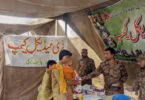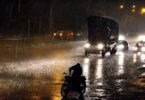F.P. Report
PESHAWAR: As tourism plays an important role in development of any country; Pakistan is blessed with enormous beauty from tourists’ point of view hence to bring a sizeable foreign exchange to national exchequer.
The Khyber Pakhtunkhwa is a land of scenic splendors of beautiful mountains and hill places where hundreds of thousands of tourists pour in from Pakistan and different parts of the world every year to spend the holidays on the beautiful spots.
Many beautiful mountainous areas, nonetheless that could be developed as hill stations are ignored from the public view and have lacked any development to catch visitors’ interests. Even the indigenous people of the area are not facilitated with the necessities they need to have. These beautiful places seek the attention of the government for their development.
One of the mountainous splendors which could be developed as a scenic hill station for visitors is “Sheikh Badin”.
“Sheik Badin” a scenic mountainous station in the North of Dera Ismail Khan and west of Lakki Marwat districts at a height of 4,516 feet. It merits a mention here that Sheikh Badin also received snowfall during this winter.
Not much is known about the early history of ‘Sheikh Badin’ with the possible exception of a few references in the British gazetteers of Khyber Pakhtunkhwa.
“It was first occupied in 1860 as sanitarium. Sheikh Badin remained the summer headquarters of the Derajat Brigade and the civil officers of Bannu and Dera Ismail Khan districts also spend part of the hot season here, said the official documents of Tourism Department Khyber Pakhtunkhwa.
In the context of whatever information one finds, he traces the early settlements of Sheikh Badin in the middle of 19th century, where a shrine and a few stone-made huts raised the lives of a handful of people, some of whose grand children are still inhabiting the compounds of those houses on the top of the Sheikh Badin.
The Shrine, situated on a ridge near the top, as the majority claim, existed before the people reached there. The access to the shrine is from the top by a steep narrow track. The shrine is believed to be of the Sheikh Baha-ud-Din, a Sufi Saint from Persia and probably the first of the inhabitants who found a refugee in the mountains away from worldly life to seek spiritual exaltation.
The area became famous after him by many of his followers who visited the shrine for spiritual blessings. The word Sheikh Badin is a perversion of Sheikh Baha-ud-Din.
The initiation of the development of Sheikh Badin as a summer hill station began in the 1880s by the British administration though before it had remained a summer place for many people from the plain areas in the surrounding villages.
The people enduring all foot journeys or loading on mules, did all to escape from the hot summer below. A special fund was raised to construct a Dak bungalow, officers’ huts and few lower staff accommodation including a judicial lock-up. The construction of a squash court, the ruins of which still thrill a squash fan, was deemed necessary to the recreational activities of the British officers.
Later on, another fund, as the record at Tourism Department office shows, was raised few years ago to construct a 17 kilometers dirt road to the top from the bottom of Sheikh Badin near Pezu, a small cross road town, to facilitate a passage for pony-carriage caravans. The track is still the only vehicular access to the top, though its condition now, because of no repair, is too bad even to support a four-wheel jeep drive on it.
The majority of the foot climbers to the top prefer these trails because of a cut in distance. The one from village Panyala side, another tiny town in the east of Sheikh Badin bottom, is the shortest by almost four miles but with a steep ascent which many find too hard to climb said Mansoor Akbar Kudi former Vice Chancellor Gomal University who climbed here twice by foot.
The Sheikh Badin top, according to the estimate, can support a population of 25,000. Beside the housing space on the top, a lot of space exists on the ridges of the Shiekh Badin near the top where small houses can be constructed in access to main road, the documents stated.
With all these constructions, the Sheikh Badin became an official summer place for the British civil administrators of Bannu, Dera Ismail Khan and Mianwali districts. The Sheikh Badin was not made a regular summer camp like one at Razmak and Wana. It was because of the two major factors the first one not much space was available on the top to erect the full-fledged garrison necessitated in those days and the second was an unalloyed fear by the British that location of the top is such where the officer camp could easily be besieged and ambushed by the rival tribes. It was in particular during those days (1890 to 1917) when on many fronts fighting continued between the British armies and frontier tribesmen said the documents.
The Sheikh Badin enjoys a cool breezy weather in summer with wandering clouds often covering the huts on top at small distances from one another. In the wake of a cruel summer on plains during the hot days of June and July where one finds himself in the throes of heat all of sweat, the life at the top and ridges is comfortably cool. Even in the day time, inside a verandah without any electric fan one feels cool.
The small population living on the top is scattered on two square miles, which according to a civil engineer is too spacious to raise a medium community hill resort. The majority of the population, which is almost deserted in the winter, belongs to the only permanent living community of the Sheikh family. They claim to be the descendants of Sheikh Baha-ud-Din, and are called Sheikhs.
“We migrate in winter to surrounding villages near Pezu. In Winter, it is not only cold but there is a transportation problem as no traffic exists in the winters”, said an old inhabitant. To him, if a metal road is built by the government that would have brought rapid changes in the area and in their lives too.
Other than the Sheikh houses and Dak bungalow, few other stoned-houses appear near the ridges where the small cemetery 300 feet below in a saddle of Sheik Badin range having slabs of marble reminds one of the services of British officers who laid their lives on an alien land far away from their European home-land for the elevation of the British Raj in India.
The record of the average rainfall on the top of Sheikh Badin does not exist. However, it ranges from 20 to 28 inches. In 1897-8 according to the British gazetteer “the greatest fall of late years was 24 inches”. Even the meteorological department at DI Khan does not know about it, though average rain fall on the top is much higher than on the plains. The climate on the top is cool and cold and dry, perfectly suitable for a sanitarium. The major sources of water are a few springs in the lower terrains below the top, nonetheless, no facility exists to pump that water to the top.
The shortage of water remains a problem on the top as there are no proper arrangements for storing water, unlike the old days when British garrison was. The only remaining tanks where water is stored to meet the living needs are in poor shape. The stored water in tanks on top feed the residents’ drinking and living needs.
According to a native of Sheikh Badin “If the administration builds tanks and stores the rained water, it can be sufficient for many of our needs, but even no water facilitation is available to the indigenous people”.
With the exception of a few developments made under the Basic Democracies System during Ayub Khan’s regime for the repairing of dirt road and the renovation of the Dak bungalow and two water-tanks on top, no major development has taken place.
The forest department has made some development to protect the wildlife from vanishing. The area since 1972 has been declared a wildlife sanctuary. The Sheikh Badin mountain zone which has a large medium sized forest of bushes and trees is teeming with many species of wildlife, including game birds and antelopes.
The development of Sheikh Badin necessitates the importance of a hill station, many believe, in the suburbs of DI Khan, Lakki Marwat, Tank, Bannu, Mianwali, South Waziristan, North Waziristan, Karak and others districts.
“People from here travel to the summer resorts in Nathia Gali and Murree”, wished one from lower village of Shiekh Badin, “if a metal road and water reaches to top, I would have built small hut on these and would have spent my summer there” said Dr Zainullah.
The documents stated that Sheikh Badin project was launched as non ADP scheme with a cost of Rs.77.191 million in 2005. Later it was reflected as ADP scheme.
Rs 108.019 million for construction of road, Rs 038.054 million for supply of drinking water, Rs 004.098 million for supply of electricity and Rs. 003.112 million for restoration of old rest house.
Officials of KP Tourism Department, said that the provincial government was taking measures to develop the area for tourists. They said that the department has written letter to C&W department for construction of road and expressed hope that soon it would be done.






